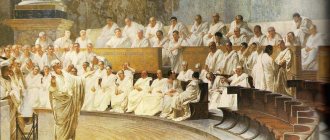Origin
Rhetoric is based on the study of the human spirit and the masterpieces of eloquence. Admiration for the powerful effect created by the oratorical genius leads a person to search for the means by which it was achieved. In ancient times, the Greeks highly valued public participation in political life. Therefore, rhetoric has become the most important tool for influencing politics. According to sophists such as Gorgias, a successful orator could speak convincingly on any topic, regardless of his experience in that field.
Law of promotion and orientation of the addressee
The second law is the law of advancement and orientation of the addressee, which requires that the listener, with the help of the speaker, be oriented “in the space” of speech and that he feels that, together with the speaker, he is moving towards the goal
.
First of all, you need to think about the general structure of the speech. The structure of the speech must be clear not only for the speaker, but also for the addressee, and for this, the speaker must “remember his purpose and main idea at all times and make them obvious to the audience. It’s good when transitions from one semantic part to another also create the impression that the speaker is moving forward, without being distracted, without getting stuck and without returning to what has already been covered.
It is easier to perceive a statement if the principles of constructing the entire phrase are followed. The phrase must have a clear structure. In rhetoric, there is such a concept as a period, about which Aristotle wrote: “I call a period a phrase that itself has a beginning and an end and the dimensions of which are easy to see. This style is pleasant and understandable; it is pleasant because it is the opposite of unfinished speech, and it always seems to the listener that he is grasping something and that something has ended for him; and not having a presentiment of anything and arriving at nothing is unpleasant. Periodic speech is understandable because it is easy to remember, and this comes from the fact that periodic speech has a number, and the number is the easiest to remember. That’s why everyone remembers poetry better than prose...”
The feeling of movement is created by the very process of performing and delivering a speech. Meaningful pauses and correctly chosen speech tempo are necessary. Repetitions should not interfere with the movement of thought, but emphasize particularly important formulations and conclusions.
History of creation
Rhetoric has its origins in Mesopotamia. The earliest examples of it can be found in the writings of the priestess and princess Enheduanna (circa 2280-2240 BC). Later ones are in the scrolls of the Neo-Assyrian state during the time of Sennacherib (700-680 BC).
In Ancient Egypt, the art of persuasion appeared during the Middle Kingdom. The Egyptians highly valued eloquence. This skill was very important in their social life. The Egyptian laws of rhetoric state that knowing when to remain silent is respected and necessary. This approach is a balance between eloquence and wise silence.
In ancient China, rhetoric dates back to Confucius. His tradition emphasized the use of beautiful figures of speech.
In Ancient Greece, the use of oratory was first mentioned in Homer's Iliad. His Achilles, Odysseus and Hector were honored for their inherent ability to advise and exhort their peers and associates in wise and proper action.
Application area
Scholars have debated the scope of rhetoric since ancient times. Some limit it to a specific sphere of political discourse, others cover all aspects of culture. Modern studies of the laws of general rhetoric cover a much wider range of areas than was the case in ancient times. During this time, speakers learned effective persuasion in public forums and institutions such as courtrooms and meetings. The laws of modern rhetoric apply to human discourse. It is studied in a variety of fields, including social and natural sciences, religion, fine arts, journalism, fiction, digital media, history, architecture and cartography, alongside more traditional legal and political fields.
Principles and laws of rhetoric (speech behavior)
Modern rhetoric proceeds from the fact that there is virtually no passive side in a communicative act. The role of the listener is as active as the role of the speaker. The success of communication depends on the interaction of these two parties. The speaker should not “defeat” the audience, but “cooperate” with it.
of Cooperation becomes the universal principle of successful communication.
, formulated by G. P. Grice. Any communication, including business, is not the path of one person to another, but a movement towards each other. This principle regulates the quantity and quality of information provided by each of the communicants at one or another stage of verbal communication. For example, a rule governing quantity requires that the speaker neither withhold necessary information that is fundamental to making a decision on the issue under discussion, nor disclose information that is not required.
The principle of cooperation and communicative cooperation requires the correct performance of communicative roles: speaker – listener. We have all encountered such a situation in dialogue when we wanted to, but could not speak out. Excessive speech activity of one partner sometimes prevents the other from even indicating his position.
The rules for organizing and optimizing dialogue representing information exchange also include the principle of Interest.
This principle means that dialogic communication develops more dynamically if the information conveyed is of interest to all participants. At the same time, each of the negotiators pursues and satisfies a double interest: regarding the substance of the matter and the relationship between the partners. Relationships based on trust, respect and friendliness allow each subsequent negotiation to turn into a calmer and more effective process.
The next principle developed by modern rhetoric and especially relevant for business communication is the Pollyana principle.
This principle requires that the content of verbal communication meet the criteria for the optimistic mood of the participants.
Recently, a violation of harmony between the tonality and meaning of a statement has been quite common. Leading financiers and experts can talk about the country's difficult economic situation with a smile, peppering their speech with jokes. And business negotiations are often conducted from “losing” positions, positions of disbelief in one’s own strength.
According to the Pollyana principle, even those parties who have not reached an agreement or a compromise solution at the conclusion of negotiations must express hope for resolving the conflict situation or resolving the issue. And you need to start negotiations with faith in your own strength, common sense and the goodwill of your partner.
In business dialogic speech, very often the dynamics of dialogue development are reduced due to repetitions, returns to what has already been said, and unmotivated deviations from the topic. When negative emotions take over, showdowns begin, the parties move away from solving the problem and the principle of Consistency
In the development of the topic.
If the principle of consistency of speech is violated, it can be difficult to concentrate and restore the sequence of thoughts. Therefore, speakers have to return to the same question again and again. In addition to a waste of time, such conversations often end in communication failure.
Pleasure Principle
- This is a universal principle of communication.
We try to communicate more with those who are interesting to us and with whom it is pleasant to talk. In order to win over the interlocutor, they use a wide range of means with the help of which Attraction
. These include:
Etiquette formulas: we have the honor to offer you, dear Nikolai Petrovich, etc.;
Addressing a person by name (proper name technique);
A technique conventionally called the “relationship mirror”
: kind smile, pleasant facial expression. During the dialogue, not only verbal means of communication (words) are taken into account, but also non-verbal ones (facial expressions, gaze, posture, distance, etc.), which provide indirect data about the mood, feelings of the partner, his disposition towards the interlocutor.
The circumstances of life, sometimes poor health are reflected on our face with a grimace of irritation and fatigue, sometimes gloominess and even anger. To enter into a business contact with such a facial expression means harming not only oneself, but also the business, because on the face of the interlocutor, as in a mirror, you will see your mood. Mutual irritation can cause communication failure.
To the Laws
speech behavior, or the laws of modern rhetoric, include the following:
1. Conceptual law. It involves systematizing the discussion material, a comprehensive analysis of the subject of speech and building knowledge about it.
2. The law of audience modeling. Involves knowledge of the audience (interlocutor). The portrait of any audience is determined, firstly, by socio-demographic characteristics (gender, age, nationality, level of education, profession), secondly, by socio-psychological characteristics (level of understanding of the problems discussed, attitude towards the subject of speech) and thirdly, individual personality traits (type of nervous system, temperament, mentality, etc.)
3. Strategic law. Based on the characteristics of the audience (interlocutor) and on the basis of the concept and plan, a strategy and a specific program of action are built.
4. Tactical law. Based on the developed strategy, it provides for the use of certain tactics in the communication process in order to interest the interlocutor, provoke him to think and communicate.
5. The law of verbal expression. Provides the ability to put thoughts into effective speech form, logically and colorfully prove your “theses”. Cicero’s formula says: “An orator is one who will present any question with knowledge of his matter, harmoniously and gracefully, with dignity in execution.”
6. The law of effective communication. Provides the ability to establish, maintain and strengthen contact with the audience (interlocutor), to win their sympathy, attention, and interest. To do this, you need to manage your own behavior, manage the behavior of the audience, and adjust, if necessary, the meeting plan.
7. System-analytical law. Assumes the ability to analyze the results obtained.
The conceptual law is fundamental, since the success of communication largely depends on the ability to analyze a situation and make a decision; the laws of audience modeling, strategic, tactical, verbal expression, effective communication “work” on the first law. Knowing them makes it possible to correctly implement the concept.
The significance of the system-analytical law is that it helps to assess the quality of the concept itself and analyze all stages of its implementation: find strong and weak links, correcting shortcomings.
Thus, the laws of rhetoric reflect the systematic nature of speech activity and following them determines communicative success.
We examined the basic principles and laws of modern rhetoric that are applicable in business communication. Principles differ from laws in their selectivity, but laws are universal in nature, that is, they are used in any type of communication.
www.iteconomic.com
Civic art
Rhetoric was considered a civic art by some ancient philosophers. Aristotle and Isocrates were the first to see it in this light. They argued that the laws of speech and the rules of rhetoric are a fundamental part of the social life of every state. This science is capable of shaping a person's character. Aristotle believed that the art of persuasion could be used in public in three different ways:
- Political.
- Judicial.
- Ceremonial.
Rhetoric is a public art that has the power to shape opinion. Some ancients, including Plato, found fault with it. They argued that it could be used to deceive or manipulate, with negative consequences for civil society. The masses were unable to analyze or decide anything for themselves, so they could be swayed by the most persuasive speeches. Civil life could be controlled by those figures who knew how to make the best speech. This concern continues to this day.
Teacher's speech culture
The teacher’s speech should be formed by the following components:
- Right;
- Accuracy;
- Logic;
- Purity;
- Expressiveness;
- Diversity;
- Relevance.
In a teacher’s speech, one can encounter errors that impoverish it. Here are the most common among them:
- Violation of lexical compatibility in sentences;
- Replacing words with words that are similar in sound but different in meaning;
- Misuse of words regarding their meaning;
- Using unnecessary words;
- Tautology;
- Replacement or loss of words that violate the meaning of what was said.
Early school
Over the centuries, the study and teaching of the laws and rules of rhetoric have been adapted to the specific requirements of time and place. It suited a variety of uses, from architecture to literature. Learning originated in the school of philosophers known as the Sophists around 600 BC. e. Demosthenes and Lysias became the main orators during this period, and Isocrates and Gorgias became outstanding teachers. Rhetorical education is built on the four laws of rhetoric:
- invention (inventio);
- memory (memoria);
- style (elocutio);
- action (actio).
Modern teaching continues to refer to these laws in discussions of the classical art of persuasion.
Law of Pleasure
The fourth law of rhetoric is the law of pleasure. Speech is then and therefore effective when it gives pleasure to the listener (interlocutor). First of all, by creating a gaming setup, “riddles” that the listener solves together with the speaker. Ability to use paradox, pun, word play
- this is what will help the speaker please the listener. At the same time, you need to remember; speech should not turn into empty chatter. And yet, pleasing the listener does not mean avoiding difficult questions, sometimes even unpleasant ones. In any situation, you need to remember the culture of communication.
School of the Middle Ages
In the Middle Ages, the laws of rhetoric were taught in universities as one of the three original liberal subjects, along with logic and grammar. With the rise of European monarchs in subsequent centuries, it passed into court and religious applications. Augustine had a strong influence on Christian rhetoric during this time, advocating its use in the church.
After the fall of the Roman Republic, poetry became a tool for rhetorical training. Writing was considered the main form through which state and church affairs were conducted. The study of verbal arts has been in decline for several centuries. This was followed by a gradual increase in formal education, culminating in the rise of medieval universities. Rhetorical writings of the late Middle Ages include those of Saint Thomas Aquinas and Matthew of Vendôme.
Late school
In the 16th century, education in the field of rhetoric was more restrained. Influential scholars such as Ramus believed that the process of invention and organization should be elevated to the realm of philosophy.
In the 18th century, the art of persuasion began to play a more serious role in social life. This led to the emergence of a new education system. “Schools of oratory” began to emerge. In them, women analyzed works of classical literature and discussed pronunciation tactics.
With the rise of democratic institutions at the end of the 18th and beginning of the 19th centuries. the study of the subject has experienced a renaissance. Scottish writer and theorist Hugh Blair became a true supporter and leader of the new movement. In his work “Lectures on Rhetoric and Fiction,” he promotes the ability to persuade as a resource for social success.
Throughout the twentieth century, the discipline developed as a concentrated field of study, with the creation of courses in rhetoric in many educational institutions.
Laws
The Four Laws of Rhetoric, discovered by Aristotle, serve as a guide to creating persuasive arguments and messages. This:
- the process of developing and arranging arguments (invention);
- choosing how to present your speech (style);
- the process of learning words and persuasive messages (memory);
- pronunciation, gestures, tempo and tone (delivery).
There is an intellectual debate going on in this area. Some argue that Aristotle considers rhetoric to be the art of persuasion. Others believe that it involves the art of judgment.
One of Aristotle's most famous doctrines was the idea of "general themes." The term most often referred to "argumentation loci" (a list of modes of reasoning and categories of thought) that a speaker could use to generate arguments or evidence. Themes were an ingenious tool designed to help categorize and better apply commonly used arguments.
Law of harmonizing dialogue
The first law of rhetoric, the law of harmonizing dialogue, states: effective verbal communication is possible only with dialogic interaction between participants in a speech situation.
.
Let us reveal the essence of this law.
The term “dialogue” in modern rhetoric has a different, more general and broader meaning. Rhetoric fundamentally denies the possibility of “speech addressed to oneself.” Rhetoric (as the science of effective, influencing, harmonizing speech) is simply not interested in such speech. In rhetoric, not only the speaker, but also the listener is understood as an active, active person. This is how Aristotle saw the relationship between the speaker and the addressee. This vision is especially close to the Russian speech ideal. To live means to participate in dialogue: to question, listen, respond, agree, etc. In this dialogue, a person participates with his whole life: with his eyes, lips, hands, soul, spirit, whole body, actions. He includes all of himself in the word, and this word enters into the dialogical fabric of Human life, into the world symposium.
So, the law of harmonizing dialogue says that your interlocutor or audience is not a passive object to whom you must convey information, on which you, as a speaker, are called upon to influence. Your task is to “awaken the listener’s own inner word”, to establish a harmonious and two-way relationship with the addressee. We will discuss how to dialogize verbal communication in the next paragraph.
Analysis methods
The laws of rhetoric can be analyzed by various methods and theories. One of them is criticism. This is not the scientific method. It involves subjective methods of argumentation. Critics use a variety of means when examining a particular rhetorical artifact, and some even develop their own unique methodology. Modern criticism examines the relationship between text and context. In determining the persuasiveness of a text, one can examine its relationship to audience, purpose, ethics, argumentation, evidence, layout, delivery, and style.
Another method is analytics. The object of rhetorical analysis is usually discourse. Therefore, it is very similar to discourse analysis. The goal of rhetorical analysis is not simply to describe the statements and arguments put forward by the speaker, but to identify specific semiotic strategies. Once analysts discover the use of language, they move on to questions:
- How it works?
- What impact does it have on the audience?
- How does this effect provide more clues about the speaker's goals?
Principles of dialogization of speech communication
In order to dialogize verbal communication, i.e. In order to get an active response to the speaker’s speech, you need to know the principles of speech behavior.
The first principle is attention to the addressee.
When preparing for a public speech, professional or personal conversation, first of all, you need to imagine a listener, an interlocutor. What are the characteristics of his personality (character, tastes, interests). Are there any topics that should not be discussed?
Rhetoric recommends, when thinking about a speech, to draw up in advance a “social portrait of the listener (audience).” It is created as a result of answers to the following questions:
1) the social status of the listener or the social composition of the audience; social role of the interlocutor in relation to you (manager; teacher; friend; parent, etc.)
2) audience size (number of people);
3) age;
4) the range of special interests of the addressee and a set of “forbidden topics”, personal characteristics of the interlocutor (character, education, upbringing...);
5) why and why people gathered; what will be done as a result of the meeting, conference;
6) how your message relates to the personal, pressing interests and needs of the recipient;
 How will they use the information they receive from you? When? How?
How will they use the information they receive from you? When? How?
Once again, I would like to emphasize that the work of drawing up a portrait of the addressee is very useful in any situation: both when preparing for a conversation of a personal or business nature, and when preparing for a public speech. Analysis of the audience will help you think through the course of the conversation, it will help you dialogize even a monologue speech in public speaking - the use of rhetorical questions, appealing to listeners.
The second principle of dialogization of speech is the principle of proximity of the content of speech to the interests and life of the addressee. Having previously assessed and imagined the audience, you need to think through those facts, examples, images that are taken from an area that is vital or familiar, interesting, and accessible to your listener. Human nature is such that he experiences more acutely what concerns him personally, what is close to him.
Imagine that an emergency happened: somewhere abroad; In your city; in your house. Experiments show that understanding a text directly depends on how close its content is to the interests of the addressee: the greater this proximity, the fewer options for understanding are found. Therefore, rhetoric recommends showing throughout the entire conversation or speech why what is being communicated is personally important to the addressee, how the issue being discussed directly concerns his vital interests.
The third principle is specificity.
Specificity helps to visually perceive the sounding word, and this is very important for understanding and memorization.
There must be examples - specific manifestations and confirmation of your thoughts.
Pay attention to the imagery of speech.
Select words: it is better to use not a generic concept, but a specific one (not a headdress, but a hat
;
not a transport
,
but a trolleybus
).
When thinking about the structure of your speech, formulate the topic or individual questions as specifically as possible.
Strategy
Rhetorical strategy is the author's attempt to persuade or inform his readers. Writers use it. There are various argumentation strategies that are used in writing. The most common of them:
- arguments from analogy;
- arguments from the absurd;
- mental exploration;
- conclusions for the purpose of better explanation.






